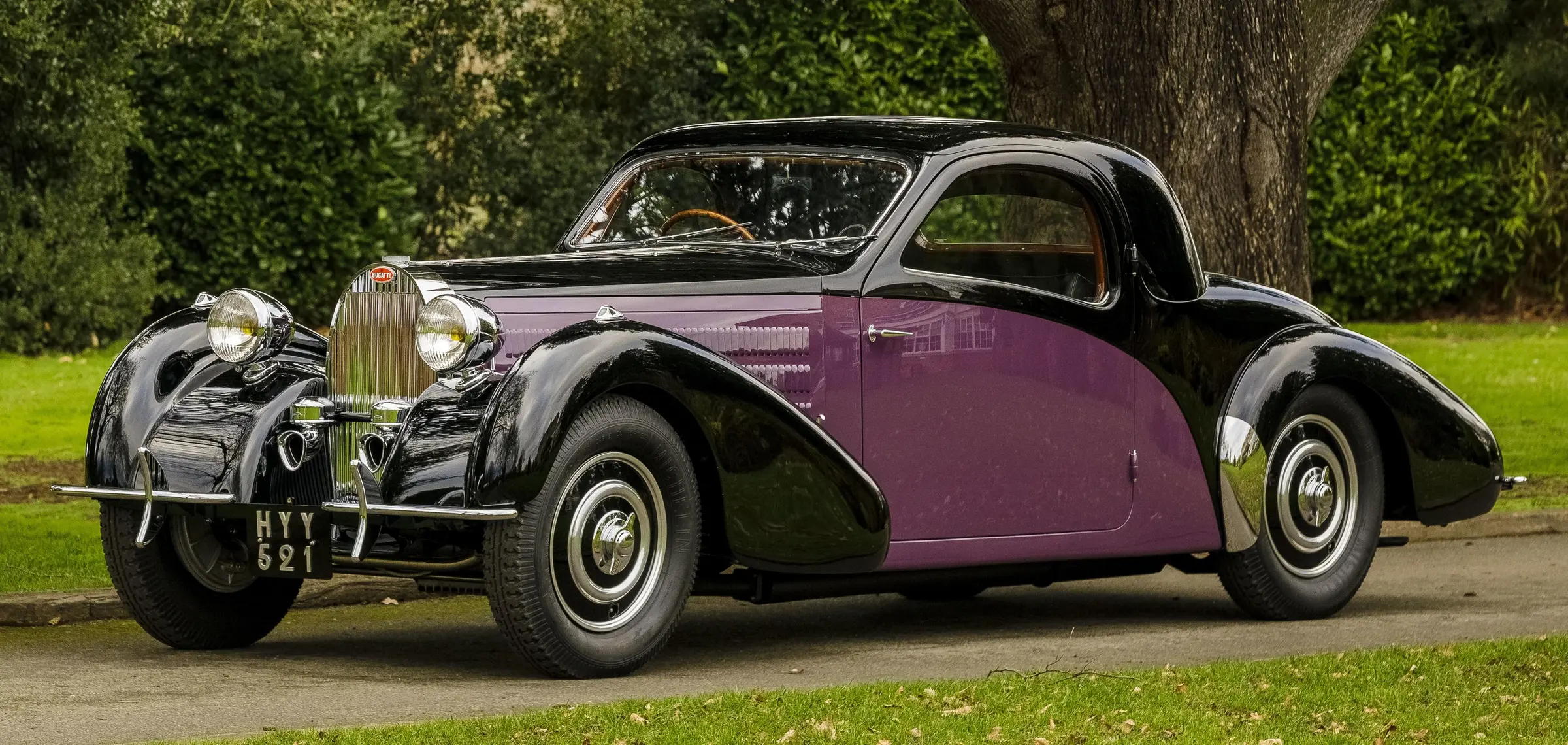The 1939 Bugatti Type 57C Gangloff Atlante Coupe chassis no. 57775 stands as an enduring symbol of automotive artistry and engineering excellence. A blend of elegance, speed, and luxury, this car encapsulates the golden age of automobile design, where craftsmanship and performance coalesced into remarkable machines. The Bugatti Type 57C is not just a car; it is a piece of history, a reflection of the social dynamics of its time, and an icon of the automotive world.
In this article, we will explore the design, history, and significance of the Bugatti Type 57C Gangloff Atlante Coupe chassis no. 57775. From its engineering marvels to its place in automotive history, we will delve into what makes this car a revered classic.
The Legacy of Bugatti
Founded by Italian-born engineer Ettore Bugatti in 1909, Automobiles Bugatti quickly established itself as a manufacturer of high-performance cars known for their beauty and technical innovation. The brand became synonymous with luxury, exclusivity, and unrivaled performance. Ettore Bugatti’s vision was to create vehicles that combined aesthetic appeal with exceptional engineering, a principle that remains integral to the Bugatti brand today.
The Type 57 was introduced in 1934 as a successor to the Type 49 and soon became the flagship model for Bugatti. Characterized by its streamlined design and powerful engine, the Type 57 laid the foundation for Bugatti’s reputation as a leader in the luxury automobile market. Variants of the Type 57, including the Type 57C, would later emerge, solidifying Bugatti’s status as a legendary automotive manufacturer.
The Bugatti Type 57C: A Marvel of Engineering
The Bugatti Type 57C is notable for several reasons, most importantly its groundbreaking engineering features. The “C” in 57C stands for “surcompresseur,” which is French for “supercharged.” This feature allowed the car to achieve higher performance levels compared to its naturally aspirated counterparts.
Engine and Performance
The Type 57C is powered by an 3.3-liter inline-eight engine, which was capable of producing around 135 horsepower. The supercharger significantly enhanced the engine’s output, allowing the vehicle to reach top speeds of over 90 mph (145 km/h). This performance made the Type 57C a formidable competitor in the racing world and an attractive option for wealthy buyers seeking both speed and style.
The chassis of the Type 57C is constructed from lightweight materials, contributing to its agility and handling. The car features a four-speed manual transmission, providing drivers with a responsive and engaging driving experience. The suspension system, comprised of independent front suspension and a live rear axle, offered a smooth ride and impressive stability, even at high speeds.
Design and Aesthetics
Bugatti’s commitment to aesthetics is evident in the design of the Type 57C. The car features flowing lines, a low silhouette, and a distinctive grille that embodies the Art Deco style of the era. The bodywork is crafted with meticulous attention to detail, showcasing the craftsmanship that Bugatti is renowned for.
One of the most iconic aspects of the Type 57C is its dual-cowl design, which enhances the car’s aerodynamic profile while adding a touch of elegance. The interior of the Type 57C is equally impressive, featuring luxurious materials such as leather upholstery and polished wood trim, providing both comfort and sophistication for its occupants.
The Gangloff Atelier: Craftsmanship at Its Finest
The Bugatti Type 57C Gangloff Atlante Coupe chassis no. 57775 was manufactured by Gangloff, a coachbuilder based in France known for its exquisite body designs. Founded by the Gangloff family in 1919, the atelier became a prominent name in the world of automotive coachbuilding, crafting bespoke bodies for luxury automobile manufacturers, including Bugatti.
The Relationship Between Bugatti and Gangloff
The collaboration between Bugatti and Gangloff exemplified the synergy between engineering and artistry. While Bugatti focused on performance and engineering excellence, Gangloff brought a distinct artistic flair to the body design. This partnership resulted in some of the most beautiful and iconic cars of the era.
The Gangloff Atelier specialized in creating streamlined bodies that enhanced the aerodynamic properties of vehicles. The atelier’s craftsmen paid careful attention to every detail, ensuring that each car was a unique masterpiece. The collaboration between Bugatti and Gangloff allowed for customization, with clients able to specify unique features that reflected their tastes and preferences.
The Atlante Coupe Design
The Bugatti Type 57C Gangloff Atlante Coupe is distinguished by its elegant design and aerodynamic profile. The sleek lines and curved fenders create a sense of motion, even when the car is stationary. The elongated hood and flowing rear end further contribute to its graceful appearance.
The car’s interior is equally remarkable, featuring a combination of luxury and functionality. The seats are upholstered in high-quality leather, providing comfort for both the driver and passengers. The dashboard is adorned with polished wood, and the controls are intuitively arranged for easy access.
Chassis No. 57775: A Unique Story
Chassis no. 57775 holds a special place in the history of the Bugatti Type 57C. It is one of the few surviving examples of the Gangloff Atlante Coupe, making it a sought-after collector’s item. The car was completed in 1939, at a time when Europe was on the brink of World War II, which significantly impacted the automotive industry.
The Early Years
The early years of chassis no. 57775 were marked by a combination of luxury and performance. The car was likely owned by a prominent individual, as was common for Bugatti vehicles of this caliber. Its early history remains somewhat obscure, but it is believed to have been used for both leisurely drives and racing events.
Restoration and Preservation
As with many classic cars, the history of chassis no. 57775 includes periods of neglect and restoration. Over the years, the car has undergone several restorations to preserve its original beauty and functionality. Enthusiasts and collectors recognize the importance of maintaining the car’s authenticity, and efforts have been made to source original parts whenever possible.
Today, chassis no. 57775 stands as a testament to the craftsmanship and engineering excellence that defined the Bugatti brand. It is frequently showcased at classic car events and auctions, attracting attention from collectors and enthusiasts alike.
The Cultural Impact of the Bugatti Type 57C
The Bugatti Type 57C, particularly the Gangloff Atlante Coupe chassis no. 57775, has left an indelible mark on automotive culture. It symbolizes the intersection of art and engineering, representing a time when cars were not just machines but works of art.
A Symbol of Luxury
During its time, the Bugatti Type 57C was a symbol of wealth and status. Owning such a vehicle was a mark of distinction, and it reflected the owner’s appreciation for fine craftsmanship and performance. The exclusivity of the Bugatti brand, combined with the bespoke nature of Gangloff’s designs, made these cars highly coveted.
Influence on Automotive Design
The design principles embodied by the Bugatti Type 57C continue to influence automotive designers today. The emphasis on aerodynamics, elegant lines, and attention to detail can be seen in modern luxury cars. The car’s legacy lives on in contemporary automotive design, where aesthetics and performance remain paramount.
Iconic Status in Film and Media
The Bugatti Type 57C has appeared in various films, documentaries, and media, further cementing its status as an icon of automotive history. Its striking design and historical significance make it a popular choice for filmmakers seeking to capture the essence of luxury and elegance.
Conclusion
The 1939 Bugatti Type 57C Gangloff Atlante Coupe chassis no. 57775 is more than just a car; it is a masterpiece that embodies the pinnacle of automotive engineering and design. Its blend of performance, luxury, and artistry captures the spirit of an era marked by innovation and elegance.
As we reflect on the legacy of the Bugatti Type 57C, we are reminded of the importance of preserving such treasures of automotive history. Cars like the 57775 serve as a bridge between the past and the future, connecting us to a time when craftsmanship and performance reigned supreme.
In a world where technology continues to evolve rapidly, the Bugatti Type 57C remains a timeless symbol of beauty and excellence. Whether admired at car shows, showcased in collections, or celebrated in popular culture, chassis no. 57775 will forever hold a special place in the hearts of automotive enthusiasts and collectors alike.




